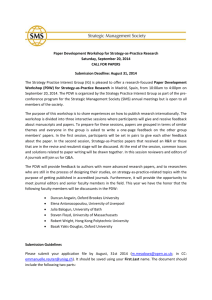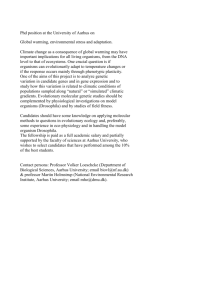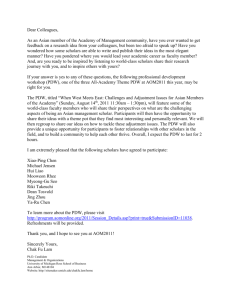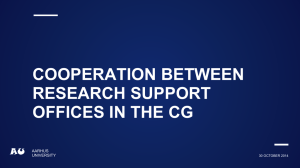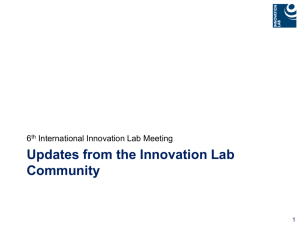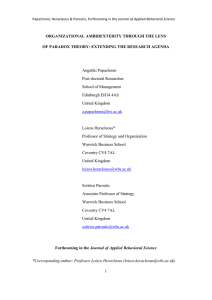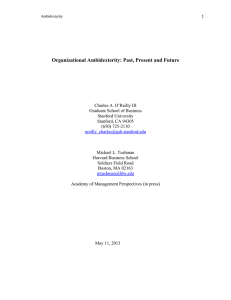Exploring HRM in new(er) organizational forms: Managing people in
advertisement
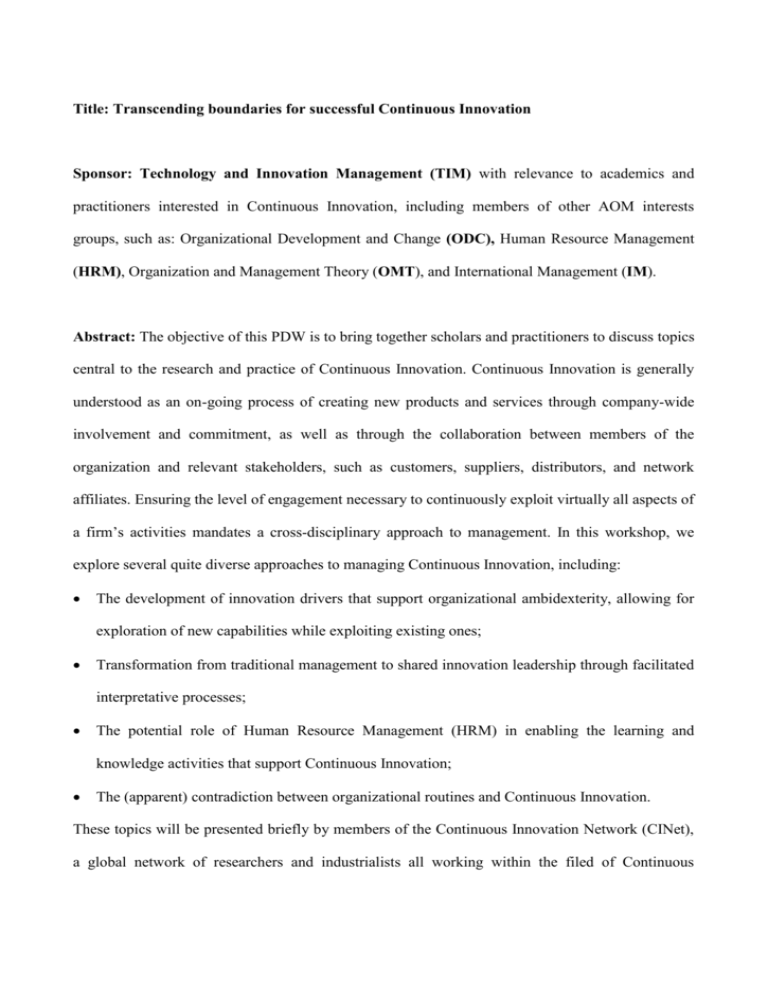
Title: Transcending boundaries for successful Continuous Innovation Sponsor: Technology and Innovation Management (TIM) with relevance to academics and practitioners interested in Continuous Innovation, including members of other AOM interests groups, such as: Organizational Development and Change (ODC), Human Resource Management (HRM), Organization and Management Theory (OMT), and International Management (IM). Abstract: The objective of this PDW is to bring together scholars and practitioners to discuss topics central to the research and practice of Continuous Innovation. Continuous Innovation is generally understood as an on-going process of creating new products and services through company-wide involvement and commitment, as well as through the collaboration between members of the organization and relevant stakeholders, such as customers, suppliers, distributors, and network affiliates. Ensuring the level of engagement necessary to continuously exploit virtually all aspects of a firm’s activities mandates a cross-disciplinary approach to management. In this workshop, we explore several quite diverse approaches to managing Continuous Innovation, including: The development of innovation drivers that support organizational ambidexterity, allowing for exploration of new capabilities while exploiting existing ones; Transformation from traditional management to shared innovation leadership through facilitated interpretative processes; The potential role of Human Resource Management (HRM) in enabling the learning and knowledge activities that support Continuous Innovation; The (apparent) contradiction between organizational routines and Continuous Innovation. These topics will be presented briefly by members of the Continuous Innovation Network (CINet), a global network of researchers and industrialists all working within the filed of Continuous Innovation. Thereafter, the speakers will facilitate small group discussions aimed at sharing the workshop attendants’ experiences with both research and practice of Continuous Innovation. The workshop will end with a plenum discussion of the shared experiences, highlighting critical areas still to be investigated. Moreover, we hope to use this forum to discover common research interests that could provide the foundation for future collaboration between AOM members and members of CINet. Description of PDW On a continuum of approaches to organizational change, Continuous Innovation is often situated near the middle between Continuous Improvement on one end and radical innovation on the other and consequently shares important features with each. In particular, Continuous Innovation is characterized by a steady stream of input from employees throughout the organization and even external stakeholders such as customers, suppliers, and network partners in much the same way as Continuous Improvement (CI), which has which has its roots in the Japanese practice of Kaizen (Imai, 1987). Rather than focusing simply on product, service, and process improvement through, for example, problem solving, however, like with radical innovation, Continuous Innovation emphasizes the creation of products, services, and processes that are new to the organization, market and/or world (Bessant, 1992; Magnussen & Martini, 2008). On the other hand, radical and/or discontinuous innovation occurs most often in only select areas of the organization, such as the R&D department, and relies on contributions from experts that often occur in relatively sudden “spurts” (Bessant, 2010). Both the ongoing, processual nature of Continuous Innovation and the need for high levels of involvement from employees and external stakeholders present unique challenges for management. In this workshop, we aim to provide an overview of various approaches to managing Continuous Innovation. Specifically, we will elaborate on the following: Ambidextrous organizations are able to simultaneously explore new capabilities while exploiting existing ones (Duncan, 1976), which is an ability that is positively associated with firm performance (Gibson & Birkinshaw 2004; He & Wong, 2004; Tushman & O’Reilly, 1996). Still, developing and managing ambidexterity poses critical challenges for management. We will present research aimed at identifying how organizations can develop a set of innovation drivers that support organizational ambidexterity, thereby ensuring the constant level of innovation activities needed for superior performance. During interpretative processes, discursive communities are created among interconnected CoPs to create shared multi-voiced understanding. Comparing among perspectives generates polyphony, maybe even cacophony and some new ideas to re-draw boundaries between CoPs and shape new practices together. These outcomes of interpretative mode are quite different from those used in the rhetoric of analytical approaches. (Gherardi & Nicolini 2002). Switching from interpretative mode to analytical mode requires a paradigm shift in terms of management style that does not simply occur, but rather must be facilitated (Schreyögg & Geiger, 2007). We will explore how interactive and interpretive innovation processes can be fostered by shared innovation leadership (Lester & Priore, 2004) embedded in communities of practices (CoPs) (Brown & Duguid 1998; Cook & Brown 1999; Amin & Cohendet 2004). Recently, efforts have been made to link specific or bundled HR practices to organizational learning, change, and innovation (Langbert & Friedman, 2002; Jørgensen, Laugen, & Boer, 2007; Laursen & Foss, 2003). To date, however, most of the HRM literature has been based on theories and models developed on large American manufacturing firms (Brewster, 1995) and thus there is a need to understand how HRM can support innovation and improved organizational performance in SMEs, and non-manufacturing contexts, such as knowledgeintensive and service firms. Findings from empirical studies targeted at identifying how HRM practices can be designed and implemented in various organizational contexts to support sustained innovation will be presented. There is a broad common sense among researchers that a routinization of processes leads to rigidities and path dependencies (Nelson & Winter 1982; Teece, Pisano & Shuen 1997; Betsch et al. 2001). Even more: to unfold the benefits of routine (including a decreased deliberation necessity, an improved result, and an improved coordination), a certain level of stability seems to be required. In contrast, continuous innovation requires a certain level of flexibility; activities have to be questioned, re-planned, and changed. It is still unclear how to overcome this apparent contradiction. We will summarize the main aspects of this contradiction and explore how continuous innovation interacts with the development of routine. PDW Participants 1. (PDW Coordinator) Frances Jørgensen, PhD is Associate Professor of Human Resource Management and Development at Aarhus School of Business, Aarhus University, Denmark. Her research interests include HRM and HRD, and specifically their role is supporting innovation, continuous improvement and innovation, employee participation and motivation in organizational change. She has numerous research publications related to these interests. She is a long-standing member of the Continuous Innovation Network (CINet). Address: Haslegaardsvej 10, Aarhus V, 8210 Aarhus, Denmark. Email: fraj@asb.dk 2. Norris Krueger, PhD is Clinical Professor of entrepreneurship and program managers for Entrepreneurship Northwest, a joint venture of Idaho TechConnect, the Idaho National Laboratory, the Inland Northwest Research Alliance and member schools. Norris is considered an expert on how we learn to think entrepreneurially and how we translate this way of thinking into teaching and practice. In addition, his interests range from social entrepreneurship to neruoentrepreneurship. He has published in JBV and ETP and has contributed with book chapters in Acs’ Handbook of Entrepreneurship Research and The Entrepreneurial Mind, as well on and constructivism in entrepreneurship education. He is External Fellow, Max Planck Institute of Economics. 3. Theresa Michl, PhD researcher at the Munich School of Management of the LudwigMaximilians-University (LMU), Munich, Germany. Theresa Michl teaches in the field of organization and management theory as well as in the field of statistics. Her research focuses on the interdisciplinary field of economics, management and psychology and her work is published in book chapters and academic journals. Besides, Theresa Michl has profound presentation experience from several international conferences as well as extraordinary moderation and mediation experience from her education as a team trainer. With her paper “Managing strategic ambidexterity: the spin-along approach“, she won the John Bessant Best Paper Award at CINet conference 2010. 4. Arnold Picot, PhD holds the chair of the Institute for Information, Organization and Management at the Munich School of Management at Ludwig-Maximilians-Universität (LMU), Munich, Germany. Arnold Picot’s research and teaching activities focus on core fields of management, namely organization theory, theory of the firm, strategy and entrepreneurship, innovation, management implications of new technologies, telecommunications, media and regulation. Beside LMU Arnold Picot has taught at Stanford University, Technical University of Munich, University of Hannover, Georgetown University, and University of Strasbourg amongst others. His research has been supported by the German National Science Foundation (DFG), the Volkswagen Foundation, the German Federal Ministry of Research and Education and other funding agencies. He is an editorial board and review member of various academic and professional journals, book series and yearbooks. Arnold Picot is the (co)author of around 30 books and over 400 journal articles and book chapters. 5. René Rohrbeck, PhD is Associate Professor for Strategy at the Aarhus School of Business and Social Sciences, Aarhus University. His research interests are organizational change, strategy as practice, innovation management and organizational future orientation. His research has been published in R&D Management, Technology Analysis & Strategic Management, Technological Forecasting and Social Change and in several books, including his thesis on “Corporate Foresight: Toward a Maturity Model for the Future Orientation of a Firm”. René Rohrbeck has 6 years of practical experience in the ICT and automotive industry, where he worked at Deutsche Telekom and Volkswagen on strategic management, innovation management and corporate foresight. In addition he has served as a consultant for multinational companies in the energy and manufacturing industry. 6. Anne Kallio, M.Sc. Econ. is a researcher at LUT Lahti School of Innovation. She has designed and conducted over ten action research processes in different innovation environments. Kallio has been responsible for developing a tool to reveal the innovation potential that hides in the everyday work in organizations. She sees herself to balance between the modes of analytical and interpretative innovation viewpoints. Her research interests include absorptive capacity, social capital and employee-driven innovation in the interface of analytical and interpretative innovation. 7. Tuija Oikarinen, D.Sc. Econ. & Bus.Adm is a senior researcher at Lappeenranta University of Technology, Lahti School of Innovation. Her research interest is in organizational renewal studied from viewpoints of organizational learning, practice-based innovation, and human resources management. Her background is in business life and entrepreneurship. During the recent years in the University she has worked in multiple action research based projects as project manager and researcher. The projects have focused on the challenge how to create innovation in the midst of action in business organizations. 8. Anne Pässilä, PhD researcher at Lappeenrenanta University of Technology, Lahti School of Innovation. She applies an interpretative approach to the innovation process, specializing in applying art-based methods to support social dimension of learning related to innovation and development processes. She develops and investigates a methodological approach in which applied theatre and story-telling methods are utilized to involve employees of organizations and networks in development work; communication and confidentiality that form the basis for innovations are strengthened; and ability and willingness to engage in reformatory activities are induced. 9. Peter Kesting is Associate Professor of Management at the Center for Organizational Renewal and Evolution (CORE), Aarhus University, Denmark. As an educated economist, his research interests focus on the conceptual and cognitive foundation of routine and decision making in the face of disruptive change and innovations. Here he is particularly interested in the conceptual distinction between continuation, continuous improvement, and disruptive innovation and the specific challenges that follow from that for managerial decision-making. Currently, he is also working on the relation between different forms of innovation and business model dynamics. PDW Format The workshop is designed to be interactive with active involvement of all participants. Presentations Schedule The PDW is planned as a 2 ½ hour interactive workshop using the following schedule: Duration Topic 20 min. Panelists Welcome and Introduction: Defining and Frances Jørgensen distinguishing Continuous Innovation 20 min. Organizational Ambidexterity and Innovation Norris Krueger, Theresa Michl, Arnold Picot, and René Rohrbeck 20 min. Shared leadership for innovation through Anne Kallio, Tuija Oikarinen interactive and interpretive discourse and Anne Pässilä 20 min. HRM in support of innovation Frances Jørgensen 20 min. Continuous Innovation and organizational Peter Kesting routines 30 min. Facilitated Small Group Discussion Panelists and Participants 20 min Wrapping up and call for interest in collaborative Panelists and Participants research between AOM and CINet members References Amin, A. & Cohendet, P. 2004. Architectures of Knowledge: Firms, Capabilities and Communities. Oxford.: Oxford University Press. Bessant, J. 1992. Big Bang or Continuous Evolution: Why Incremental Innovation is Gaining Attention in Successful Organisations. Creativity and Innovation Management, 1(2): 52-69. Bessant, J., Von Stamm, B., Moeslein, K. & Neyer, A. 2010. Backing outsiders: selection strategies for discontinuous innovation, R&D Management, 40(4): 345-356. Betsch, T., Haberstroh, S., Glöckner, A., Haar, T., & Fiedler, K. 2001. The effects of routine strength on adaptation and information search in recurrent decision making. Organisational Behaviour and Human Decision Processes, 84: 23–53. Brewster, C. 1995. Toward a European model of human resource management. Journal of International Business Studies, 1:1-21. Brown, J. S., & Duguid, P. 1994. Borderline issues: Social and material aspects of design. HumanComputer Interaction, 9(1): 3-36. Cook, J., & Brown, J. S. 1999. Bridging epistemologies: The generative dance between organizational knowledge and organizational knowing. Organization Science, 10(4): 381-400. Duncan, R. 1976. The ambidextrous organization: Designing dual structures for innovation. In R. H. Killman, L. R. Pondy, & D. Sleven (Eds.) The Management of Organization. New York: North Holland. Gibson, C.B. & Birkinshaw, J. 2004. The antecedents, consequences, and mediating role of organizational ambidexterity. Academy of Management Journal, 47(2): 209-226. Gherardi, S. & Nicolini, D. 2002. Learning the Trade. A Culture of Safety in Practice, Organization. Organization, 9: 191-223. He, Z., & Wong, P., 2004. Exploration vs. Exploitation: an empirical test of the ambidexterity hypothesis. Organization Science, 15(4): 481–494. Imai, K. (1987). Kaizen. New York, Random House. Jørgensen, F., Laugen, B. and Boer, H. 2007. Human resource management for continuous improvement. Creativity and Innovation Management, 16(4): 363-375. Langbert, M. & Friedman, H. 2002. Continuous improvement in the history of human resource management”, Journal of Management Decision, Vol. 40, No.8, pp. 782-787. Laursen, K. & Foss, N.J. 2003. New human resource management practices, complementarities, and the impact on innovation performance. Cambridge Journal of Economics, 27: 243–63. Lester, R. & Piore, M. 2004. Innovation: The Missing Dimension. Cambridge, MA: Harvard University Press. Magnusson, M. & Martini, A. 2008. Dual organizational capabilities: from theory to practice - the next challenge for continuous innovation. International Journal of Technology Management, 42(1/2): 1-19. Nelson, R. R. & Winter, S. G. 1982. An Evolutionary Theory of Economic Change. Cambridge, MA. The Belknap Press of Harvard University Press. Schreyögg, G. & Geiger, D. 2007. The significance of distinctiveness: A proposal for rethinking organizational knowledge. Organization, 14: 77-100. Teece, D.J., Pisano, G. & Shuen, A. 1997. Dynamic Capabilities and Strategic Management, Strategic Management Journal, 18: 509-533. Tushman, M.L. & O'Reilly III, C.A., 1996. Ambidextrous organizations: managing evolutionary and revolutionary change. California Management Review, 38(4): 8-30. Frances Jørgensen: "I have received signed statements from all intended participants agreeing to participate for the entire workshop, AND that these participants are not in violation of the Rule of Three + Three."
